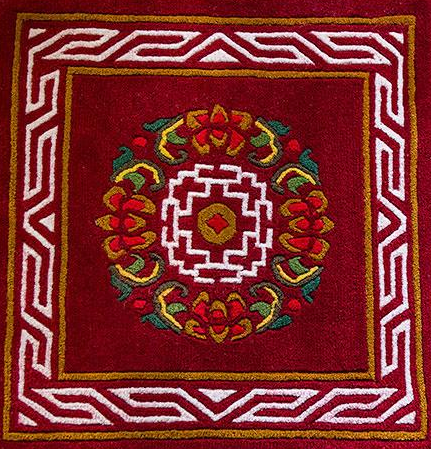Tablet weaving – the ancient method of weaving ornamental belts and apron bands – is assumed to have come to Nepal from Tibet. It is practised only in some northern areas and in Kathmandu, where a large number of Tibetan refugees have settled. Here tablet weaving has become more tourist-oriented: rather than adorning a traditional dress or apron a tablet-woven band might appear around a tourist’s neck as a camera strap or as a tie-belt around jeans.
PROCESS & TECHNIQUE
In tablet weaving the warp yarn is threaded through holes in flat tablet. By manipulating the tablets – giving them a slight turn – shed and counter-shed can be opened for the weft yarn to be inserted. Depending on how the colours are threaded and which tablets are turned, a wide variety of patterns can be achieved. In Nepal, four-hole leather tablets are usually used.
The weaving takes place on a back-strap loom. The loops from the starter nail are transferred onto a stick and the warp is placed over the breast beam and two wooden bars, one some 80 cm above the other. These are fixed with strong loops to a wall. The weaver sits in front of the wall with the breast beam held by the back-strap and the warp forming a triangle in front of her. This method is particularly suitable for tablet weaving as the weaver can control the tension of the warp – leaning slightly forward when turning the tablets and leaning back when beating the weft. The beating is done with a small wooden beater with a metal edge set in on one side. When some weaving has been completed, the warp is simply slipped around the three poles to the position the weaver requires.
ORNAMENTATION
Highly ornamented bands are often used over the already securely tied coat. Two borders, usually of all the colours of the spectrum, frame the black, white, red and green centre section with a wide variety of patterns. These include simple geometric designs and zigzag and stripe patterns for those parts of the belt that will not be visible when it is tied around the waist twice. The ends of the belt, which do show and reflect the skill of the weaver, are adorned with meander bands, and patterns representing the swastika, the Chinese long-life symbol and religious symbols, including the butter lamp, bell, and the thunderbolt (vajra) among others.
Gallery
YOUR VIEWS
PRACTITIONERS: INDIA
Access 70,000+ practitioners in 2500+ crafts across India.
BIBLIOGRAPHY
10,000+ listings on arts, crafts, design, heritage, culture etc.
GLOSSARY
Rich and often unfamiliar vocabulary of crafts and textiles.
SHOP at India InCH
Needs to be written.






